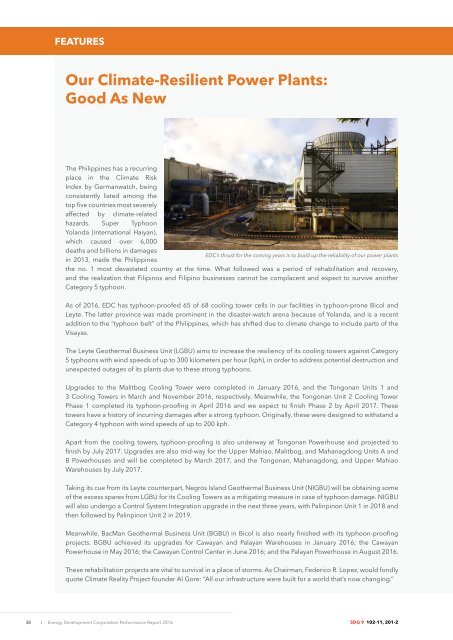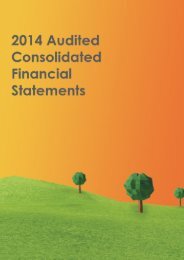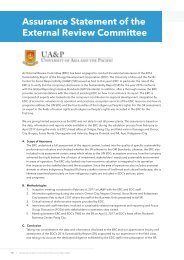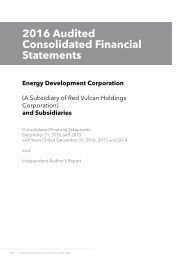EDC PR 2016 (EC section)
You also want an ePaper? Increase the reach of your titles
YUMPU automatically turns print PDFs into web optimized ePapers that Google loves.
Features<br />
Our Climate-Resilient Power Plants:<br />
Good As New<br />
The Philippines has a recurring<br />
place in the Climate Risk<br />
Index by Germanwatch, being<br />
consistently listed among the<br />
top five countries most severely<br />
affected by climate-related<br />
hazards. Super Typhoon<br />
Yolanda (international Haiyan),<br />
which caused over 6,000<br />
deaths and billions in damages<br />
<strong>EDC</strong>’s thrust for the coming years is to build up the reliability of our power plants<br />
in 2013, made the Philippines<br />
the no. 1 most devastated country at the time. What followed was a period of rehabilitation and recovery,<br />
and the realization that Filipinos and Filipino businesses cannot be complacent and expect to survive another<br />
Category 5 typhoon.<br />
As of <strong>2016</strong>, <strong>EDC</strong> has typhoon-proofed 65 of 68 cooling tower cells in our facilities in typhoon-prone Bicol and<br />
Leyte. The latter province was made prominent in the disaster-watch arena because of Yolanda, and is a recent<br />
addition to the “typhoon belt” of the Philippines, which has shifted due to climate change to include parts of the<br />
Visayas.<br />
The Leyte Geothermal Business Unit (LGBU) aims to increase the resiliency of its cooling towers against Category<br />
5 typhoons with wind speeds of up to 300 kilometers per hour (kph), in order to address potential destruction and<br />
unexpected outages of its plants due to these strong typhoons.<br />
Upgrades to the Malitbog Cooling Tower were completed in January <strong>2016</strong>, and the Tongonan Units 1 and<br />
3 Cooling Towers in March and November <strong>2016</strong>, respectively. Meanwhile, the Tongonan Unit 2 Cooling Tower<br />
Phase 1 completed its typhoon-proofing in April <strong>2016</strong> and we expect to finish Phase 2 by April 2017. These<br />
towers have a history of incurring damages after a strong typhoon. Originally, these were designed to withstand a<br />
Category 4 typhoon with wind speeds of up to 200 kph.<br />
Apart from the cooling towers, typhoon-proofing is also underway at Tongonan Powerhouse and projected to<br />
finish by July 2017. Upgrades are also mid-way for the Upper Mahiao, Malitbog, and Mahanagdong Units A and<br />
B Powerhouses and will be completed by March 2017, and the Tongonan, Mahanagdong, and Upper Mahiao<br />
Warehouses by July 2017.<br />
Taking its cue from its Leyte counterpart, Negros Island Geothermal Business Unit (NIGBU) will be obtaining some<br />
of the excess spares from LGBU for its Cooling Towers as a mitigating measure in case of typhoon damage. NIGBU<br />
will also undergo a Control System Integration upgrade in the next three years, with Palinpinon Unit 1 in 2018 and<br />
then followed by Palinpinon Unit 2 in 2019.<br />
Meanwhile, BacMan Geothermal Business Unit (BGBU) in Bicol is also nearly finished with its typhoon-proofing<br />
projects. BGBU achieved its upgrades for Cawayan and Palayan Warehouses in January <strong>2016</strong>; the Cawayan<br />
Powerhouse in May <strong>2016</strong>; the Cawayan Control Center in June <strong>2016</strong>; and the Palayan Powerhouse in August <strong>2016</strong>.<br />
These rehabilitation projects are vital to survival in a place of storms. As Chairman, Federico R. Lopez, would fondly<br />
quote Climate Reality Project founder Al Gore: “All our infrastructure were built for a world that’s now changing.”<br />
38<br />
I Energy Development Corporation Performance Report <strong>2016</strong><br />
SDG 9 102-11, 201-2
















